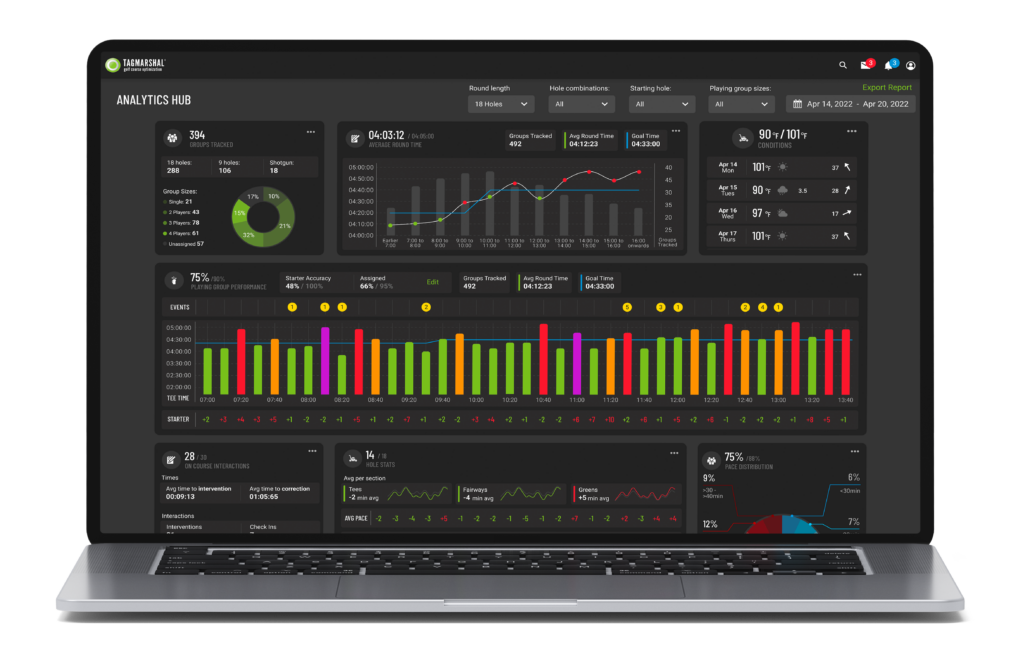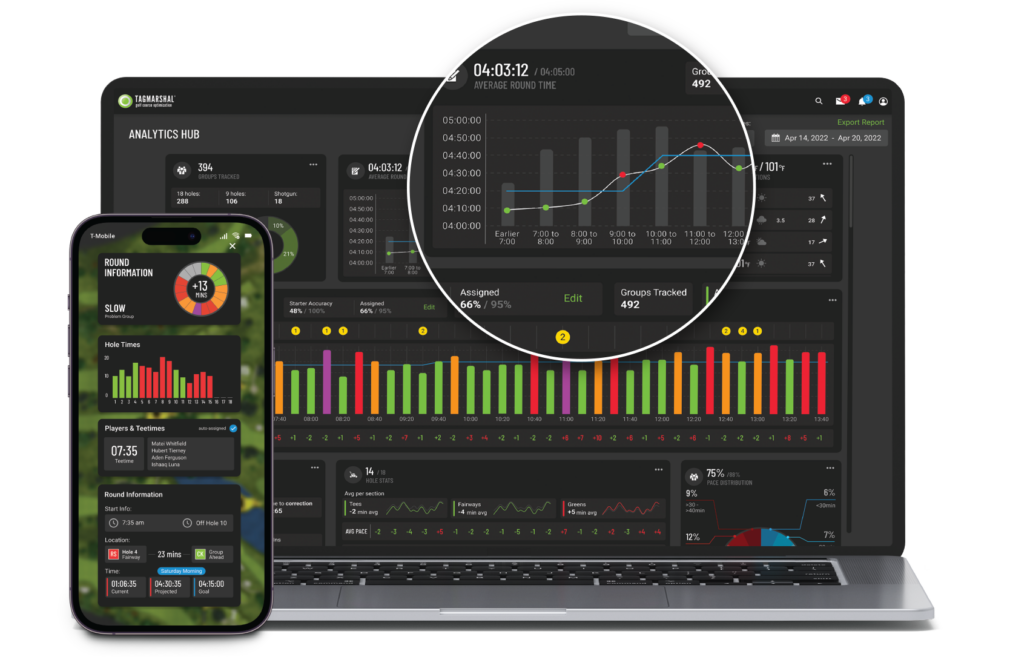Moving the fundamentals forward
Article by Guy Cipriano, Golf Course Industry
What is Data?
Unknowingly, many golf maintenance pros are already using data to support decisions.
“What we have to realize is what data is: It’s written-down observations,” says Dr. Bill Kreuser, the president and co-founder of GreenKeeper, a service offering science-based information, products and recommendations to turfgrass managers. “Superintendents are some of the most observant people and they keep track of what they are seeing. Turning it into data is the next step of writing it down or logging it somewhere so that you don’t live in the moment, and you can look for long-term trends.”
Bodo Sieber, the CEO of Tagmarshal, a system designed to help golf facilities navigate on-course traffic, compares a golf course to the human body. Data ensures operations are conducted at peak efficiency.
“If you go for a health check and you know what your critical body KPIs are, you can make better decisions, and adjust your lifestyle,” Sieber says. “If you’re trying to run a marathon, trying to get fit, and if you don’t engage the science behind what your body needs, then you’re going to try, but you’re going to fail. It’s the same with a golf operation.”
Sieber adds that data comes in two forms: what’s happening in real-time and what has happened over time. Soil and air temperatures, golf cart and maintenance vehicle movement, and soil moisture levels are examples of real-time data being accumulated on golf courses. Clipping yields, Growing Degree Days, and spray and fertility records are examples of historic data.
A position for THAT?
Data and analytics have become so prevalent in professional sports that nearly every major franchise devotes full-time personnel to interpreting them.
Could a need for similar personnel and departments reach golf facilities? Full-time data analysts are unlikely — and unnecessary — in golf course management, according to Tagmarshal CEO Bodo Sieber. “That would be complete overkill,” he says.
Instead of hiring a data analyst, Sieber recommends facilities identifying and developing a “champion” for prodding their property in a data-driven direction. Once that person is selected, they should receive opportunities to research how various platforms can help the course achieve its goals.
“You don’t need to be a data scientist,” Sieber says. “You need to play people to their strengths. If somebody is a little bit more technical and likes digging into data and systems, then make them the champion and empower them. Make it their mission. They can add a lot of value by teaching, training others, and answering their questions.”
GreenKeeper president and co-founder Dr. Bill Kreuser also doesn’t view a data manager position as a necessity for a golf facility because automation offered by emerging platforms will simplify numerical-based decisions.
“The old-school method might have been you hire a data analyst, and they dig and pull up databases and try to make connections,” Kreuser says. “With how fast things are moving on the tech side, we will be able to get a lot of value through automation. These services are cheaper. Computer scientists make them, and we can apply them to all sorts of industries and sectors. We’re just brining it to the golf sector.”
How can data help?
In addition to conducting research and working with turf managers, Kreuser assists in the maintenance and management of Jim Ager Memorial Golf Course, a 9-hole, par-3 layout and learning center in Lincoln, Nebraska. Measuring clippings and tracking growth rates supports fertility decisions on Ager’s greens, while data provided via a sensor resulted in a steep fertility reduction on fairways, according to Kreuser.
“Having that consistent product is important and we have overall doubled the amount of rounds at the par-3 at Lincoln Ager, because people know when they go there they can expect consistent, firm, fast putting greens and they can work on their short game,” Kreuser says. “Having consistency in the end product is important for the course.”
Using data collected via a traffic management platform can lead to a direct ROI. Studying historic and live traffic patterns can help operators adjust tee time and better position maintenance employees around play. Data on how long it takes golfers to play holes can be incorporated into course setup decisions to boost pace of play.
“Even if we can shave two minutes off these two holes, three minutes off that hole, one minute on this hole and two minutes at the halfway house, we have shaved off 10 minutes,” Sieber says. “That means one additional tee time that we never had. One more tee time means four times $80 the club never had.”
Sieber’s company recently worked with a course in Colorado to determine why one hole took nearly five minutes longer to complete than its projected time. The data they collected determined a medium-sized bush impeded play. The bush was removed. “It was a very low-cost exercise, and they never would have known that, because there are a lot of those bushes on the course,” Sieber says. “None were an issue besides this one.”
Sieber adds that effective data integration using automated programs will clear time for the most important and often most enjoyable part of a golf job: cultivating relationships.
“Very often at a golf facility the staff needs to make things work while their hair is on fire, because they are short-staffed and there’s always more to do,” Sieber says. “The less time I have to run around and try to make things work at my golf course, collect data points and use reams of paper to write down things so that I can stay ahead of things, the more time I have to build relationships and add to the experiences of the players I’m serving.”
What’s next?
Sieber admits that golf lags behind many other industries in collecting data besides basic financial information. He sees positives in the slow start.
“The good news is that it’s obviously easier to jump onto something that another industry has pioneered,” Sieber says. “They have done the hard part. If it took another industry 10 or 15 years to get to a certain point, you can hopefully get there in eight years or shorter.”
Dozens of effective apps and platforms have entered the golf maintenance market over the past decade. And dozens more are coming.
“The adoption curve will accelerate over the next three years and technology will continue to get better and improve,” Dorer says. “There was a day when the handheld soil monitoring devices weren’t on a golf course. Now pretty much everybody has one.
“What’s the next step? What do you do with that data? Right now, it’s helping maybe in daily operations, but I think where it’s going to help is in more planning and providing higher levels of predictability.”
Predicting exactly where, when and how superintendents will incorporate and utilize data might be as tricky as winning a March Madness office pool. Superintendents are a fundamentally imaginative group.
“The creativity and inventiveness in how to apply some of these tools by superintendents is really amazing and we’re actually counting on that,” Dorer says. “We know that we can’t think of all the different ways they can use data.”
ABOUT TAGMARSHAL
Tagmarshal, the market leader in on-course optimization technology, provides courses with full, real-time operational oversight and reporting, giving golf operators the tools to manage pace and flow of play effectively, resulting in enhanced player experiences, increased efficiency through automation, and additional revenue generation.
Tagmarshal’s technology has collected over 10 billion data points from more than 75 million rounds of golf and has relationships with in excess of 700 partners, including Hazeltine, Whistling Straits, Baltusrol, Fieldstone, Bandon Dunes, Serenoa and Erin Hills.
Tagmarshal partners with several golf management groups, private, daily fee, public and resort courses, including 40 of the Top 100 US courses, as well as many $40-$60 green fee courses, which are seeing excellent results using the system.



 WATCH DEMO
WATCH DEMO